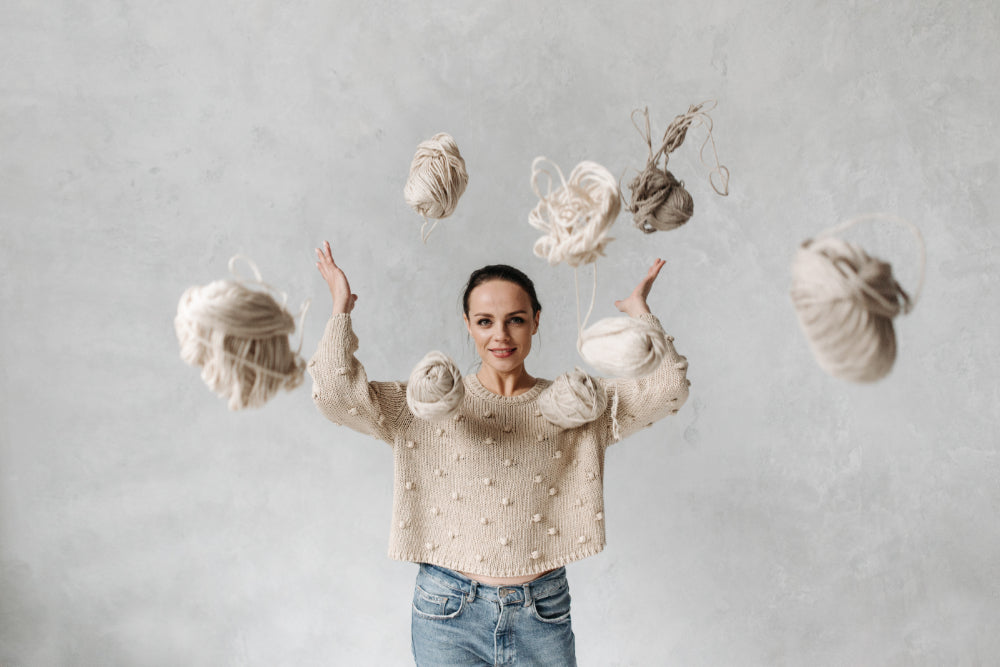
Fiber! No, not that kind...The Yarn Kind!
Share
Natural fibers are a favorite of fiber artists for a reason. They are protein based from animals or cellulose from plants. They are renewable, odor resistant, soft, easy to care for and temperature responsive – yep, they keep you cool when you are hot and warm when you’re not! Some are naturally hypo-allergenic, others are even naturally flame resistant! They come in a rainbow of colors and all kinds of textures. So many choices! What’s not to love?
Even so, the varying properties of each natural fiber might make one a better choice over another in certain situations. Going with whatever is recommended in your pattern is always your best bet. After all, the pattern was designed with that yarn in mind because of its special properties. But did you ever wonder why a particular yarn was the best choice?
A lot has to do with the specific fiber used to spin the yarn. Some designs feature a beautiful stitch and want to ensure the details aren’t lost. Other designs are flowing and need a yarn with drape. Others will feature texture.
To better understand why a particular fiber may be used in a particular project we should first take a quick look at the properties of some. Let’s take a peek at protein fibers first.
Alpaca: spun from the hair of alpacas. Fibers are lightweight, insulating, and wick away moisture keeping you warm and dry. Alpaca fibers do not hold their shape as well as others, so they are often spun with another fiber to add elasticity. [1]
Angora: spun from the fur of angora rabbits. Angora fibers are actually hollow making it very lightweight. Due to this the fibers have a “floaty” or “flyaway” characteristic known as loft; it’s what causes angora wool to have that soft, ethereal appearance often referred to as halo. The hollow core also makes the fibers very insulating so you will be toasty warm if you wear this luxuriant fiber. [2]
Cashmere: spun from the soft undercoat of cashmere goats. The silky, delicate fibers are highly insulating and very light and considered the ultimate in luxury. Fibers are often blended with other types, such as wool, for added weight. [3]
Lambswool: spun from many breeds of young sheep. Finer than sheepswool, lambswool fibers are softer and gathered during the first shearing. The degree of softness can vary according to the specific breed of the sheep. The fibers are highly regarded because of their hypoallergenic, breathable and moisture wicking properties. Fibers can have a certain degree of bend or crimp that gives a wonderful texture to the fibers. [4]
Llama: spun from the undercoat of llamas. Fibers from the North American llama are similar to that of the alpaca. Fibers gathered from the undercoat are used for spinning and offer protection from heat and cold. [5]
Merino Wool: spun from the wool of Merino sheep. Merino is highly regarded because it is so soft, warm, lightweight, wrinkle resistant, breathable, stain resistant and biodegradable. Whew! The fibers are thinner than other types of sheep wool. Because of this, the fibers are more flexible and less itchy. We like that! Merino fibers wick away moisture so you feel dry and comfortable making it a great fiber for base layer garments and socks! [6] [7]
Mohair: spun from the hair of the angora goat (not the rabbit). Mohair fibers have a natural sheen that lends a lustrous finish to wool spun with it. It’s lightweight, breathable and pliable making it a durable fiber. The hollow fibers are insulating and will not pill or matt together. [8]
Shetland: spun from the wool of Shetland sheep. Shetland sheep hail from the Shetland Islands in the UK. The breed is hundreds of years old and is the mainstay of Fair Isle knitting. Shetland sheep can yield both fine and coarser fibers with various levels of crimp. [9]
Silk: spun from fiber produced by silk worms. The fibers are very strong and very desirable due to how soft, smooth, and shiny it is. [10]
Mulberry Silk: spun from the fiber produced by the mulberry butterfly, aka: the Bombyx mori moth. [11]
Here are a few of the popular cellulose fibers you may run across.
Bamboo: a natural plant fiber from bamboo grass. This breathable fiber inhibits bacteria growth and is strong and soft with a good luster and drape. This fiber feels nice against the skin, but it is heavier than cotton and wool. [12]
Viscose: a semi-synthetic fiber made from wood pulp and sometimes bamboo. The wood is made into pulp and then through a chemical process (which is why this is considered semi-synthetic) is made into a solution which is used to make filaments, which are spun into yarn. These fibers possess a beautiful lustrous sheen and lovely drape, but do not have much elasticity. [13]
Hemp: a natural plant fiber from hemp. This storied bast fiber is stronger, longer and more absorbent than cotton fibers and not very elastic and cannot be bleached. Blending with other fibers will add elasticity, as well as, the characteristics of whatever it is blended with.[14]
Cotton: a natural fiber from the cotton plant. Absorbent, strong, lightweight, but not very elastic. Cotton is a wonderfully soft fiber that is comfortable against the skin.[15]
So, which yarn do you ask to the dance? Well, it really depends on how you would like your final project to look, feel and behave. For instance, are you making a beautiful shawl that you would like to be a bit more formal? Perhaps something that is smooth and has a lovely drape and even a luxurious sheen. Silk, mulberry silk, bamboo and viscose would be ideal choices here.
Are you working on a more casual cold-weather sweater? A nice fluffy Shetland wool would be great if you don’t want to show off an intricate stitch or if you want to subtly blur color changes. A more dense and sleek merino might be the ticket if you want to add a more crisp look to your stitches.
For a gorgeously ethereal hat and scarf you could try a floaty alpaca, angora or mohair.
Of course, there so much more information available on these fibers. Unfortunately, I don’t have room on this page to explore everything, but you can begin to get an idea of how you might favor one fiber over another depending on the project.
It is important to point out, also, that knowing your fiber is important, but fiber is not the only factor in making an informed yarn choice. Nope, you also have to consider how the fiber is spun. What sort of draft, ply and twist are imposed upon the fabulous fibers? It all makes a difference.
Until next time...happy yarnin!
XO
Linda
Shop our yarns!
Check out some of our other topics: yarn draft, fibers, gauge, needles, twist, ply and weight
How Much Yarn Do I Need?
Why avocado?
Breaking down your yarn needs
Our origin story
My yarn journey
[1] Benefits of Alpaca Fiber. Retrieved from: https://www.fibersoftheworld.com/fiber-animals/fiber-for-sale/benefits-of-alpaca-fiber/
[2] Fabric Guide: What Is Angora Wool?Retrieved from: https://www.masterclass.com/articles/what-is-angora-wool#quiz-0
[3] How is Cashmere Made. Retrieved from: https://www.masterclass.com/articles/fabric-guide-what-is-cashmere#how-is-cashmere-made
[4] Types of wool explained: merino, lambswool, Shetland & more. Retrieved from: https://blog.pendleton-usa.com/2017/04/28/types-of-wool-explained-merino-lambswool-shetland-more/
[5] All About Llama fiber or Llama Fleece. Retrieved from: https://www.jnkllamas.com/all-about-llama-fiber-or-llama-fleece.html
[6] Merino 101: Retrieved from: https://www.smartwool.com/discover/what-is-merino-wool.html
[7] Fibre. Retrieved from: https://www.woolmark.com/fibre/
[8] Mohair Fibre. Retrieved from: http://www.mohair.co.za/mohair-fibre/
[9] Shetland Wool. Retrieved from: https://www.shetland-sheep.org/about-shetlands/shetland-wool/
[10] What is Silk Fabric. Retrieved from: https://sewport.com/fabrics-directory/silk-fabric
[11] What is Silk Fabric. Retrieved from: https://sewport.com/fabrics-directory/silk-fabric
[12] Bamboo Textiles. Retrieved from: http://www.naturallifemagazine.com/0904/bamboo_textiles.htm
Bamboo Yarn. Retrieved from: https://www.10rowsaday.com/bamboo-yarn
[13] Fabric Guide: What Is Viscose? Understanding Viscose Fabric and How Viscose Is Made. Retrieved from:
[14] Hemp Fiber Production. Retrieved from: https://hempgazette.com/industrial-hemp/hemp-fiber-production/
Extraction Processing Properties and the Use of Hemp Fiber. Retrieved from: https://www.textiletoday.com.bd/extraction-processing-properties-and-use-of-hemp-fiber/
[15] Cotton Fibers – The King of Fibers. Retrieved from: https://www.textileschool.com/129/cotton-fibers-the-king-of-fibers/
